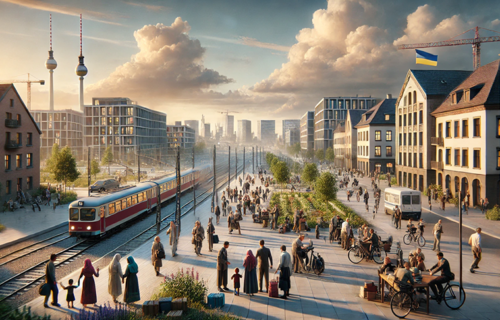Since the Russian invasion of Ukraine in February 2022, around one million refugees, primarily women and children, have sought protection in Germany. While integration into society and the labour market has been progressing, challenges such as limited childcare availability and bureaucratic hurdles in the recognition of foreign qualifications continue to pose obstacles. A recent report based on data from the IAB-BAMF-SOEP Survey of Refugees provides insights into the realities of life for Ukrainian refugees in Germany. The survey was conducted between July 2023 and January 2024 and distinguishes between two waves of arrivals: those who arrived between February and May 2022 and those who arrived from June 2022 onward.
The report highlights progress in family reunification and more stable living conditions. Women still make up the majority of adult refugees, accounting for 75 per cent of the group, but the number of men joining them has increased since 2022, helping to stabilize families. Two-thirds of adult refugees now live in stable relationships, and the proportion of women aged 20 to 49 living with minor children without a partner has fallen from 46 per cent in 2022 to 20 per cent in late 2023. Childcare participation has also increased, with 76 per cent of children aged three to six and 23 per cent of those under three attending childcare. However, both figures remain approximately 15 percentage points below the national average. Alternative childcare models could help bridge this gap and enable more mothers to enter the workforce, according to Sabine Zinn, provisional director of the Socio-Economic Panel and co-editor of the report.
School integration has generally been successful, with most Ukrainian children attending regular German classes. Only 16 per cent of school-age children remain in separate preparatory classes. However, a significant number of Ukrainian children are enrolled in middle and secondary modern schools, which may not always align with their academic potential. The report suggests that improvements are needed to ensure access to schools that match students’ abilities and aspirations.
Education remains a priority for Ukrainian refugees, with 61 per cent aspiring to vocational training or a university degree in Germany, and 16 per cent already enrolled in education programs. One-fifth of adults have applied for recognition of their qualifications, particularly in the fields of health, social services, teaching, and education. However, 73 per cent of those surveyed reported needing additional information and support in the recognition process, particularly regarding financial aspects and document requirements. Language skills have improved significantly, with 70 per cent of refugees having completed or currently attending an integration course. While 78 per cent had no knowledge of German upon arrival, this figure has now dropped to 12 per cent. More than half of respondents consider their German skills to be at least “sufficient.” Nina Rother, head of the Integration Research Department at BAMF, emphasized that flexible course formats and accessible childcare would further support language acquisition.
Labour market integration has improved, with an employment rate of 22 per cent in the second half of 2023. The likelihood of employment increases with time spent in Germany, rising from 13 per cent after 13 months to 31 per cent after 22 to 23 months. Women generally enter the workforce later than men, though their employment rate has increased by 10 per cent. Many refugees work in jobs below their qualification level, particularly in cleaning, food preparation, and social work. While 75 per cent of Ukrainian refugees hold a vocational or university degree, and nearly 90 per cent have professional experience, their potential remains underutilized in the German labour market. The report suggests that flexible working hours, expanded childcare, early career guidance, and streamlined qualification recognition processes could improve employment outcomes. Yuliya Kosyakova, head of Migration and Integration Research at IAB, stressed that reducing bureaucratic barriers and providing better access to information could accelerate integration efforts.
A majority of Ukrainian refugees intend to remain in Germany. Among those who arrived in the first wave, 59 per cent plan to stay long-term, while the figure rises to 69 per cent for later arrivals. Economic conditions in Ukraine play a significant role in these decisions, with 60 per cent citing the economic situation as a determining factor. Most refugees now live in private housing, though finding accommodation remains difficult for single individuals and those with lower educational qualifications or limited social connections.
The report also highlights the psychological strain many refugees face. Ukrainian refugees in Germany report higher levels of mental health issues compared to the general population, with 19.4 per cent experiencing depressive symptoms and 14.2 per cent showing signs of anxiety disorders. The authors recommend increasing access to low-threshold psychotherapeutic services and strengthening psychosocial support for refugees.
The findings are published in an IAB Research Report, a BAMF Research Report, and as part of the DIW Berlin’s ‘Politikberatung kompakt’ series.
Source: DIW Berlin
